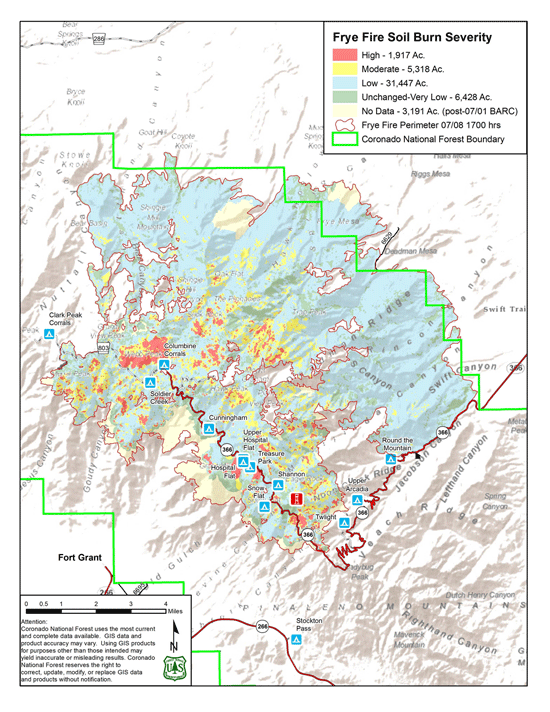Frye Fire
The Frye Fire began on 7 June 2017 from a lightning strike in the old burn scar of the 2004 Nuttall Complex Fire. The Frye Fire ranged in elevation from 1,219 to above 3,000 m, and impacted the remaining spruce-fir forest as well as much of the mixed-conifer forest where the majority of the red squirrel population currently inhabits. Preliminary assessments of burn severity from the Burned Area Emergency Response Team (BAER) estimates that 776 hectares are classified as "High" burn severity, 2,152 hectares classified as "Moderate" burn severity, and 12,726 hectares classified as "Low" severity. These ratings are based upon soil burn severity.
Conservation of the USA's rarest small mammal: SNRE involved in the conservation of the imperiled Mt. Graham red squirrels
(Click on any photo to enlarge and view details, then click to close.)
The School of Natural Resources and the Environment (SNRE) in CALS has long been involved in the conservation of federally endangered Mt. Graham red squirrels (Tamiasciurus hudsonicus grahamensis) (MGRS), found only in the Pinaleño Mountains of southeast Arizona. Dr. John Koprowski, SNRE Professor and Associate Director, and his research team of senior wildlife biologists, graduate student researchers, and undergraduate field technicians conduct regular counts of squirrel abundance and follow the movement of individuals fitted with radiocollars in several study areas within the mountain range. The research is aimed at learning as much as possible about the ecology of this highly endangered species. These techniques yield information on habitat use, nest sites, distances moved, litter size and eventually the cause of death. Such information provides insight to the challenges faced by the species and can prioritize management needs.
While fire has long been a major factor shaping the forests of the Pinaleños and thus the habitat and ecology of red squirrels, recent large wildfires have been cause for concern. The Frye Fire started in the Pinaleños on 7 June and impacted over 19,600 ha (48,443 acres) by the time it was contained in late July. A recent interagency survey reported by Arizona Game and Fish Department (https://goo.gl/2LgG1J), indicated a precipitous drop in squirrel numbers from over 250 to only 35 individuals. Impacts of the Frye Fire were reported at about 95% of the locations surveyed in the interagency census with 44% of the squirrel locations severely damaged.
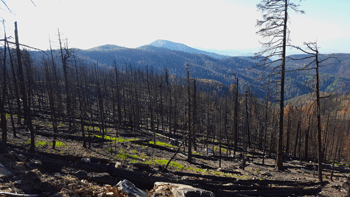 Following containment of the Frye Fire, we were allowed to safely return to the mountain range to assess the extent and severity of burn in our study areas, and how Mt. Graham red squirrels were coping with the changes. The fire impacted the majority of our study areas, including high elevation sites that contain the remaining spruce-fir vegetation community type (Photo1). While some areas experienced severe burn that killed all living vegetation, many patches of low and moderate burn remain. Trees that did not
Following containment of the Frye Fire, we were allowed to safely return to the mountain range to assess the extent and severity of burn in our study areas, and how Mt. Graham red squirrels were coping with the changes. The fire impacted the majority of our study areas, including high elevation sites that contain the remaining spruce-fir vegetation community type (Photo1). While some areas experienced severe burn that killed all living vegetation, many patches of low and moderate burn remain. Trees that did not 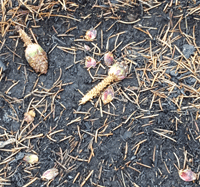 experienc
experienc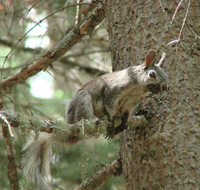 e severe burn and crown scorch are still alive and several species have produced cones this year, such as Douglas-fir (Pseudotsuga menziesii), Engelmann spruce (Picea engelmannii), and white fir (Abies concolor), and these trees are active feeding sites (Photo1A) for both red squirrels and Abert’s squirrels (Sciurus aberti) (Photo1B).
e severe burn and crown scorch are still alive and several species have produced cones this year, such as Douglas-fir (Pseudotsuga menziesii), Engelmann spruce (Picea engelmannii), and white fir (Abies concolor), and these trees are active feeding sites (Photo1A) for both red squirrels and Abert’s squirrels (Sciurus aberti) (Photo1B).
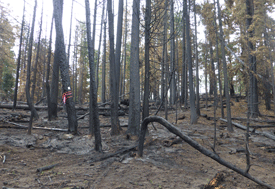 Red squirrels that survived are dealing with the changes to the forest in several ways. Many territories were severely burned, and animals are moving in search of food and new places to nest, often in previously unused areas. One individual, whose territory had been completely consumed by fire, (Photo2) moved over 1.5 km (~1mile) to establish a new cone scale pile (Photo3).
Red squirrels that survived are dealing with the changes to the forest in several ways. Many territories were severely burned, and animals are moving in search of food and new places to nest, often in previously unused areas. One individual, whose territory had been completely consumed by fire, (Photo2) moved over 1.5 km (~1mile) to establish a new cone scale pile (Photo3). 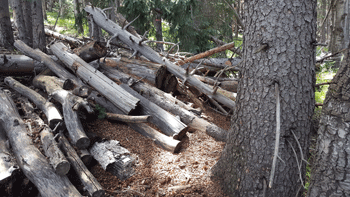 Unfortunately, these extra movements, combined with less vegetative cover, have resulted in increased mortality from avian predators (Photo4). Some squirrel territories experienced low to moderate severity ground fire that did not completely burn the cone scale pile (Photo5). Many of these partially scorched cone scale piles are still in use and squirrels are caching new cones in them (Photo6).
Unfortunately, these extra movements, combined with less vegetative cover, have resulted in increased mortality from avian predators (Photo4). Some squirrel territories experienced low to moderate severity ground fire that did not completely burn the cone scale pile (Photo5). Many of these partially scorched cone scale piles are still in use and squirrels are caching new cones in them (Photo6). 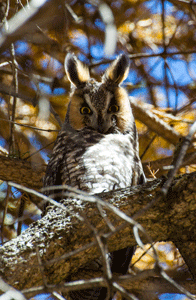
 Some cone scale piles were completely consumed by the fire, but left a network of holes in the ground where the roots of young and dead trees once were. Red squirrels have been observed caching cones in these holes (Photo7).
Some cone scale piles were completely consumed by the fire, but left a network of holes in the ground where the roots of young and dead trees once were. Red squirrels have been observed caching cones in these holes (Photo7).


Our research noted similar responses of red squirrels to other recent large fires in the Pinaleño Mountains (2004 Nuttall Complex and 1996 Clark Peak Fires). MGRS continue to avoid areas of high or moderate burn for many years after the fire; however, low levels of burn actually seemed to have some positive impacts as indicated by smaller daily ranging behavior of individuals and continued persistence of animals in such burned locations. Introduced Abert’s squirrels, a non-native competitor on Mt. Graham, respond more positively to fire and pose a continued threat. However, the Frye Fire was much larger than other recent fires and the impact may prove more severe. Post-fire management of MGRS and the forest will be critical to persistence.
A pilot conservation breeding program is also one of the strategies to ensure survival of the species. In 2011, citing concerns about ongoing drought conditions occurring on Mt. Graham, the US Fish, and Wildlife Service (USFWS) biologists collected two male and two female 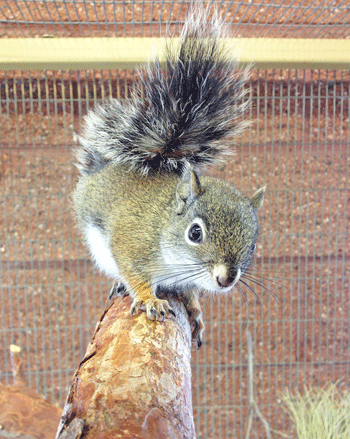 Mt. Graham red squirrels from the wild and brought them to the Johnson Center. The ACNC - Phoenix Zoo’s Arthur L. and Elaine V. Johnson Species Conservation Center (Johnson Center), was established in 2007 to work specifically on priority issues related to native wildlife species recovery. In 2014, as drought conditions continued USFWS partnered with the Johnson Center to further develop a breeding program for MGRS and added two individuals to increase the captive population to three males and three females (Photo8). Conservation Center staff has been working, towards a goal of producing offspring for release into the wild. To this end, Stuart Wells – Director of Conservation and Science at the Johnson Center is in partnership with the University of Arizona SNRE, USFWS, Arizona Game and Fish Department, and the US Forest Service. Wells is studying the behavior of these squirrels and analyzing the hormone levels in their scat to determine when the females are cycling as part of his doctoral work in SNRE, in hopes of applying this information towards developing a consistent breeding program. The program has already discovered surprising details about this critically endangered squirrel, information that could only be obtained in a managed setting. Through further study and good fortune, the program hopes to produce young for release into the wild soon. The recent population decline as a result of wildfire, heighten the importance of developing a successful propagation for release program.
Mt. Graham red squirrels from the wild and brought them to the Johnson Center. The ACNC - Phoenix Zoo’s Arthur L. and Elaine V. Johnson Species Conservation Center (Johnson Center), was established in 2007 to work specifically on priority issues related to native wildlife species recovery. In 2014, as drought conditions continued USFWS partnered with the Johnson Center to further develop a breeding program for MGRS and added two individuals to increase the captive population to three males and three females (Photo8). Conservation Center staff has been working, towards a goal of producing offspring for release into the wild. To this end, Stuart Wells – Director of Conservation and Science at the Johnson Center is in partnership with the University of Arizona SNRE, USFWS, Arizona Game and Fish Department, and the US Forest Service. Wells is studying the behavior of these squirrels and analyzing the hormone levels in their scat to determine when the females are cycling as part of his doctoral work in SNRE, in hopes of applying this information towards developing a consistent breeding program. The program has already discovered surprising details about this critically endangered squirrel, information that could only be obtained in a managed setting. Through further study and good fortune, the program hopes to produce young for release into the wild soon. The recent population decline as a result of wildfire, heighten the importance of developing a successful propagation for release program.
Mt. Graham red squirrels have persisted through past fires in their 7,000-10,000 years of residence; they are tenacious survivors and don’t give up easily (Photo9)! However, that tenacity will be tested in the coming years and the scientists from SNRE will continue to collaborate with agency and zoo biologists to enable persistence of what is now one of the USA’s rarest mammals.
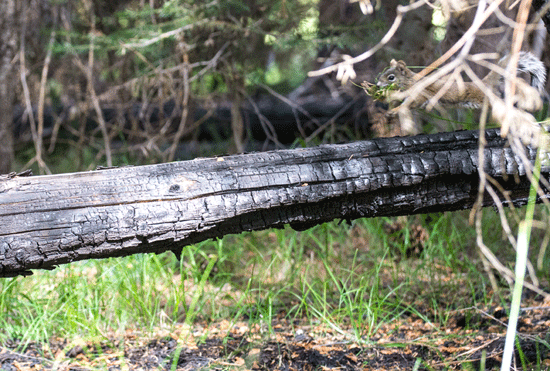
News coverage and other reading
Arizona Senator John McCain's letter in support of Mt. Graham red squirrel recovery:
https://www.mccain.senate.gov/public/index.cfm/2017/10/senator-john-mccain-urges-usfws-azgfd-to-recover-endangered-red-squirrel-species-in-arizona
Arizona Republic coverage of Frye Fire impacts:
https://www.azcentral.com/story/news/local/arizona-environment/2017/11/19/after-costly-frye-fire-endangered-squirrels-may-nearing-extinction/845306001/
Arizona Daily Star coverage of captive breeding efforts at the Phoenix Zoo:
http://tucson.com/news/local/phoenix-zoo-breeds-mount-graham-red-squirrels-to-save-them/article_52113694-a1b9-51f4-98c5-5bde4146e9e6.html
Arizona Public Media story on USFS and USFWS supplementary feeding efforts:
https://news.azpm.org/p/news-articles/2017/12/8/121061-episode-166-bringing-back-mt-grahams-red-squirrels-after-the-frye-fire/
Article on captive breeding challenges in The Revelator:
http://therevelator.org/squirrel-sex-complicated/
Links to research on Mt. Graham red squirrels and response to fire:
Blount, S.J., J.L. Koprowski. 2012. Small mammal response to post-fire conditions: case of the endangered Mount Graham red squirrel. Southwestern Naturalist. 57:8-15.
Gwinn, R. N. and J. L. Koprowski. 2017. Differential response to fire by an introduced and an endemic species complicates endangered species conservation. Hystrix doi:10.4404/hystrix-27.2-11447:1-7.
Koprowski, J. L., K. M. Leonard, C. A. Zugmeyer, and J. L. Jolley. 2006. Direct effects of fire on endangered Mount Graham red squirrels. The Southwestern Naturalist 51(1): 59-63.
Leonard, K. M. and J. L. Koprowski. 2009. Effects of fire on endangered Mt. Graham red squirrels (Tamiasciurus hudsonicus grahamensis): responses of individuals with known fates. Southwestern Naturalist 55:217-224.
Below, please find a number of helpful links with more detail on MGRS and fire:
For detailed information on the Frye Fire:
https://inciweb.nwcg.gov/incident/5221/
For information on the Mt. Graham red squirrels and our research:
https://www.ag.arizona.edu/research/redsquirrel/mgrs-main.html
For information on fires in the recent past on Mt. Graham:
https://www.ag.arizona.edu/research/redsquirrel/mgrs-data.html#fire
For fire history of Mt. Graham through the late 1900s, see Grissino-Mayer et al.s 1994 paper:
http://www.ltrr.arizona.edu/~tswetnam/tws-pdf/Graham1996.pdf
Frye Fire
The Frye Fire began on 7 June 2017 from a lightning strike in the old burn scar of the 2004 Nuttall Complex Fire. The Frye Fire ranged in elevation from 1,219 to above 3,000 m, and impacted the remaining spruce-fir forest as well as much of the mixed-conifer forest where the majority of the red squirrel population currently inhabits. Preliminary assessments of burn severity from the Burned Area Emergency Response Team (BAER) estimates that 776 hectares are classified as "High" burn severity, 2,152 hectares classified as "Moderate" burn severity, and 12,726 hectares classified as "Low" severity. These ratings are based upon soil burn severity.
 Following containment of the Frye Fire, we were allowed to safely return to the mountain range to assess the extent and severity of burn in our study areas, and how Mt. Graham red squirrels were coping with the changes. The fire impacted the majority of our study areas, including high elevation sites that contain the remaining spruce-fir vegetation community type (Photo1). While some areas experienced severe burn that killed all living vegetation, many patches of low and moderate burn remain. Trees that did not
Following containment of the Frye Fire, we were allowed to safely return to the mountain range to assess the extent and severity of burn in our study areas, and how Mt. Graham red squirrels were coping with the changes. The fire impacted the majority of our study areas, including high elevation sites that contain the remaining spruce-fir vegetation community type (Photo1). While some areas experienced severe burn that killed all living vegetation, many patches of low and moderate burn remain. Trees that did not  experienc
experienc e severe burn and crown scorch are still alive and several species have produced cones this year, such as Douglas-fir (Pseudotsuga menziesii), Engelmann spruce (Picea engelmannii), and white fir (Abies concolor), and these trees are active feeding sites (Photo1A) for both red squirrels and Abert’s squirrels (Sciurus aberti) (Photo1B).
e severe burn and crown scorch are still alive and several species have produced cones this year, such as Douglas-fir (Pseudotsuga menziesii), Engelmann spruce (Picea engelmannii), and white fir (Abies concolor), and these trees are active feeding sites (Photo1A) for both red squirrels and Abert’s squirrels (Sciurus aberti) (Photo1B).  Red squirrels that survived are dealing with the changes to the forest in several ways. Many territories were severely burned, and animals are moving in search of food and new places to nest, often in previously unused areas. One individual, whose territory had been completely consumed by fire, (Photo2) moved over 1.5 km (~1mile) to establish a new cone scale pile (Photo3).
Red squirrels that survived are dealing with the changes to the forest in several ways. Many territories were severely burned, and animals are moving in search of food and new places to nest, often in previously unused areas. One individual, whose territory had been completely consumed by fire, (Photo2) moved over 1.5 km (~1mile) to establish a new cone scale pile (Photo3).  Unfortunately, these extra movements, combined with less vegetative cover, have resulted in increased mortality from avian predators (Photo4). Some squirrel territories experienced low to moderate severity ground fire that did not completely burn the cone scale pile (Photo5). Many of these partially scorched cone scale piles are still in use and squirrels are caching new cones in them (Photo6).
Unfortunately, these extra movements, combined with less vegetative cover, have resulted in increased mortality from avian predators (Photo4). Some squirrel territories experienced low to moderate severity ground fire that did not completely burn the cone scale pile (Photo5). Many of these partially scorched cone scale piles are still in use and squirrels are caching new cones in them (Photo6). 
 Some cone scale piles were completely consumed by the fire, but left a network of holes in the ground where the roots of young and dead trees once were. Red squirrels have been observed caching cones in these holes (Photo7).
Some cone scale piles were completely consumed by the fire, but left a network of holes in the ground where the roots of young and dead trees once were. Red squirrels have been observed caching cones in these holes (Photo7). 

 Mt. Graham red squirrels from the wild and brought them to the Johnson Center. The ACNC - Phoenix Zoo’s Arthur L. and Elaine V. Johnson Species Conservation Center (Johnson Center), was established in 2007 to work specifically on priority issues related to native wildlife species recovery. In 2014, as drought conditions continued USFWS partnered with the Johnson Center to further develop a breeding program for MGRS and added two individuals to increase the captive population to three males and three females (Photo8). Conservation Center staff has been working, towards a goal of producing offspring for release into the wild. To this end, Stuart Wells – Director of Conservation and Science at the Johnson Center is in partnership with the University of Arizona SNRE, USFWS, Arizona Game and Fish Department, and the US Forest Service. Wells is studying the behavior of these squirrels and analyzing the hormone levels in their scat to determine when the females are cycling as part of his doctoral work in SNRE, in hopes of applying this information towards developing a consistent breeding program. The program has already discovered surprising details about this critically endangered squirrel, information that could only be obtained in a managed setting. Through further study and good fortune, the program hopes to produce young for release into the wild soon. The recent population decline as a result of wildfire, heighten the importance of developing a successful propagation for release program.
Mt. Graham red squirrels from the wild and brought them to the Johnson Center. The ACNC - Phoenix Zoo’s Arthur L. and Elaine V. Johnson Species Conservation Center (Johnson Center), was established in 2007 to work specifically on priority issues related to native wildlife species recovery. In 2014, as drought conditions continued USFWS partnered with the Johnson Center to further develop a breeding program for MGRS and added two individuals to increase the captive population to three males and three females (Photo8). Conservation Center staff has been working, towards a goal of producing offspring for release into the wild. To this end, Stuart Wells – Director of Conservation and Science at the Johnson Center is in partnership with the University of Arizona SNRE, USFWS, Arizona Game and Fish Department, and the US Forest Service. Wells is studying the behavior of these squirrels and analyzing the hormone levels in their scat to determine when the females are cycling as part of his doctoral work in SNRE, in hopes of applying this information towards developing a consistent breeding program. The program has already discovered surprising details about this critically endangered squirrel, information that could only be obtained in a managed setting. Through further study and good fortune, the program hopes to produce young for release into the wild soon. The recent population decline as a result of wildfire, heighten the importance of developing a successful propagation for release program. 
